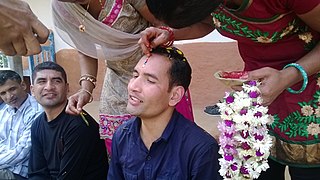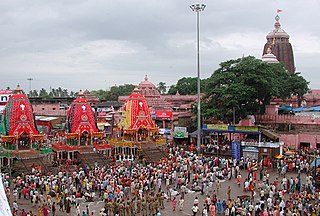The Hindu calendar, Panchanga or Panjika is one of various lunisolar calendars that are traditionally used in the Indian subcontinent and Southeast Asia, with further regional variations for social and Hindu religious purposes. They adopt a similar underlying concept for timekeeping based on sidereal year for solar cycle and adjustment of lunar cycles in every three years, but differ in their relative emphasis to moon cycle or the sun cycle and the names of months and when they consider the New Year to start. Of the various regional calendars, the most studied and known Hindu calendars are the Shalivahana Shaka found in the Deccan region of Southern India, Vikram Samvat (Bikrami) found in Nepal, North and Central regions of India – all of which emphasize the lunar cycle. Their new year starts in spring. In regions such as Tamil Nadu and Kerala, the solar cycle is emphasized and this is called the Tamil Calendar and Malayalam calendar and these have origins in the second half of the 1st millennium CE. A Hindu calendar is sometimes referred to as Panchangam (पञ्चाङ्ग), which is known also known as Panjika in Eastern India.

Ashadha or Aashaadha or Aadi is a month of the Hindu calendar that corresponds to June/July in the Gregorian calendar. In India's national civil calendar, this month is the fourth month of the year, beginning on 22 June and ending on 22 July. In Vedic Jyotish, Āsāṛh begins with the Sun's entry into Gemini. It is the first of the two months that comprise the monsoon season.

Bhai Dooj, Bhaubeej, Bhai Tika or Bhai Phonta is a festival celebrated by Hindus on the second lunar day of Shukla Paksha in the Vikram Samvat Hindu calendar or of Shalivahan Shaka calendar month of Kartika. It is celebrated during the Diwali or Tihar festival and Holi festival. The celebrations of this day are similar to the festival of Raksha Bandhan. On this day, brothers give gifts to their sisters. In the southern part of the country, the day is celebrated as Yama Dwitiya. In the Kayastha community, two Bhai Doojs are celebrated. The more famous one comes on the second day after Diwali. But the lesser-known one is celebrated a day or two after Diwali. In Haryana, a ritual also followed, a dry coconut with klewa tied along its width for worshipping is also used at the time of doing aarti of a brother.

Bhadra or Bhadrapada or Bhādo or Bhadraba is a month of the Hindu calendar that corresponds to August/September in the Gregorian calendar. In India's national civil calendar, Bhadra is the sixth month of the year, beginning on 23 August and ending on 22 September. In Vedic Jyotish, Bhadra begins with the Sun's entry into Leo, and is usually the fifth month of the year.

Ratha Yatra is a Hindu festival associated with Lord Jagannath held at Shri Khetra Puri Dham in the state of Odisha, India. It is the oldest Ratha Yatra, whose descriptions can be found in Brahma Purana, Padma Purana, and Skanda Purana and Kapila Samhita. Rath Yatra or Jatra is the celebration of the Lord Jagannath, who is believed to be the Lord of Universe's journey towards his aunt's house.

Baba Ramdev (or Ramdevji, or Ramdeo Pir, Ramsha Pir is a Hindu deity of Gujarat and Rajasthan, India. He was a fourteenth-century ruler, said to have miraculous powers, who devoted his life uplifting the downtrodden and poor people. He is worshiped by many social groups of India as Ishta-deva.
Vikram Samvat or Bikram Sambat and also known as the Vikrami calendar, is the historical Hindu calendar used in the Indian subcontinent. It is the official calendar of Nepal. In India, it is used in several states. The traditional Vikram Samvat calendar, as used in India, uses lunar months and solar sidereal years. The Nepali Bikram Sambat introduced in 1901 AD, also uses a solar sidereal year.

Kārtika is a month in the Hindu calendar that typically overlaps October and November. In the Nepali calendar, Maithili, and Bengali, it is the 7th month, in the Tamil calendar it is the 8th month.
Panchami is the fifth day (tithi) of the fortnight (paksha) in Hindu lunar calendar.
Paksha , thwa and gа̄ in Nepal Bhasa, refers to a fortnight or a lunar phase in a month of the Hindu lunar calendar.
In the Hindu calendar, Chaturdashi is the 14th day (Tithi) of the waxing phase or waning phase of the moon. This is the day prior to new moon (Amavasya) or full moon (Pournami). It has a great significance to Bengalis, as goddess Tara appeared to rishi vasistha on this tithi.
Dwadashi is the twelfth lunar day (Tithi) of the shukla (bright) or krishna (dark) fortnight, or Paksha, of every lunar month in the Hindu calendar.
Pūrṇimā is the word for full moon in Sanskrit. The day of Purnima is the day (Tithi) in each month when the full moon occurs, and marks the division in each month between the two lunar fortnights (paksha), and the Moon is aligned exactly in a straight line, called a syzygy, with the Sun and Earth. Full moon is considered the third of the four primary phases of the Moon; the other three phases are new moon, first quarter moon, and third quarter moon. The full moon shows 100% illumination, causes high tides, and can concur with lunar eclipses.
Prathama is the Sanskrit word for "first", and is the first day in the lunar fortnight (Paksha) of the Hindu calendar. Prathama is also known as Pratipada in West Bengal, Odisha and western India. Each month has two Prathama days, being the first day of the "bright" (Shukla) and of the "dark" (Krishna) fortnights respectively. Thus Prathama occurs on the first and the sixteenth day of each month. It is also known as Pratipad or Pratipada.
Tritiya is the third day in the lunar fortnight (Paksha) of the Hindu calendar. Each month has two Tritiya days, being the third day of the "bright" (Shukla) and of the "dark" (Krishna) fortnights respectively. It is Called as Tadige in Kannada.
Dashami is the Sanskrit word for "ten", and is the tenth day in the lunar fortnight (Paksha) of the Hindu calendar. Each month has two Dashami days, being the tenth day of the "bright" (Shukla) and of the "dark" (Krishna) fortnights respectively. Thus Dashami occurs on the tenth and the twenty-fifth day of each month.
Thrayodashi is the Sanskrit word for "thirteen", and is the thirteenth day in the lunar fortnight (Paksha) of the Hindu calendar. Each month has two Thrayodashi days, being the thirteenth day of the "bright" (Shukla) and of the "dark" (Krishna) fortnights respectively. Thus Thrayodashi occurs on the thirteenth and the twenty-eighth day of each month.
Here is a list of glossary of Culture of India in alphabetical order:





